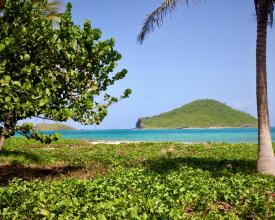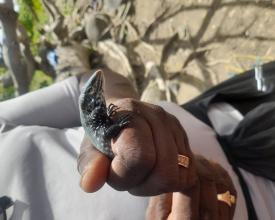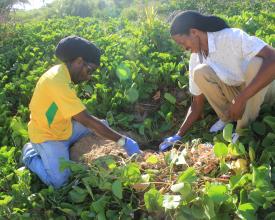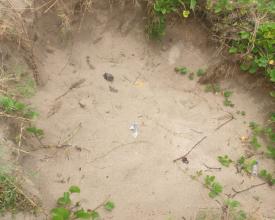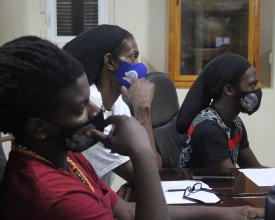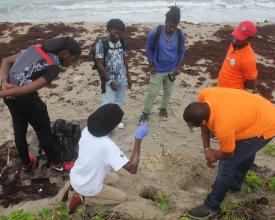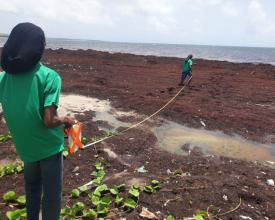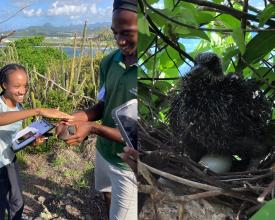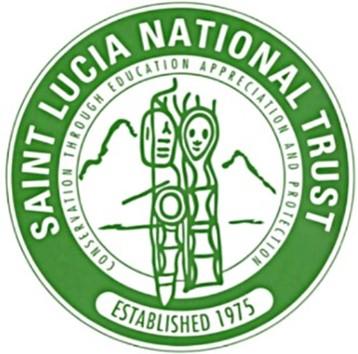
Improved capacity for Conservation Action and Sustainable Management: Data collection to inform biodiversity conservation, wildlife protection and general area surveillance programmes within the PSEPA.
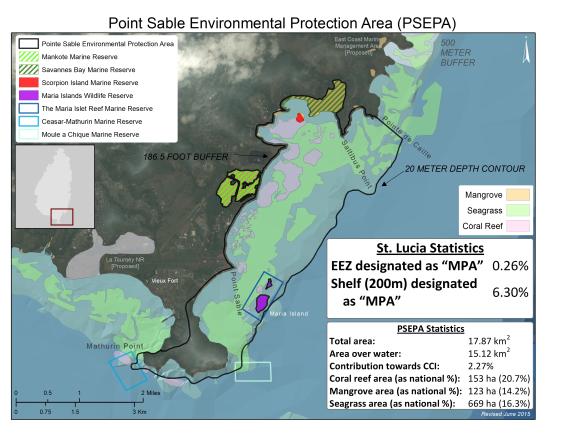
The COVID-19 pandemic reduced the income generated by the Saint Lucia National Trust (SLNT), an NGO charged with heritage conservation and the management of protected and conserved areas and biodiversity in Saint Lucia; resulting in a 60% reduction in staffing, and significant reduction in conservation and PA management activities within the Pointe Sables Environmental Protection Area (PSEPA). The PSEPA, a 1038ha site along Saint Lucia’s southeast coast inclusive of two offshore islands, is home to critically endangered species. Reduced monitoring will result in reversal of achievements under previous conservation efforts. The SLNT received a 12-month BIOPAMA Rapid Response Grant-Caribbean (RRG-C-1090) in 2021, and this facilitated a robust response to the debilitating impact of COVID-19 on its programming. RRG-C-1090 greatly improved the SLNT’s monitoring and management capacity and sustained conservation initiatives during this period of economic downturn.
Context
Challenges addressed
During COVID-19, incidents of illegal sea turtle harvesting and nest poaching increased within the PSEPA, and were reported to the police. Illegal wildlife trafficking and unsustainable use of natural resources to sustain livelihoods also increased. Monitoring capacity was urgently needed to reduce the likelihood and severity of these activities on resources and species within the PSEPA. Additionally, the national shutdown and subsequent reduction in the Trust's revenue generating capacity, forced the organisation to downsize its staff complement. This brought significant challenges as positions which were critical to the organisation’s effective conservation management programme in the PSEPA, especially the organisation's surveillance and resource conservation and mobilisation capacity within the PSEPA such as Rangers and a Project Officer/Office Manager, could not be funded due to the significant economic downturn and loss of revenue.
Location
Process
Summary of the process
In responding adequately to the challenges of the COVID-19 pandemic while allowing for continued achievement of organisational goals, the SLNT focussed on the critical programming component of conservation within the PESPA. The Building Blocks of this effort addressed the challenge of lack of human resource capacity and the traning of new recruits in the requisite skills for monitoring, surveillance and data gathering. This to address gaps created by reduced financial resources. Building Block 1 addressed the Lack of Capacity or the need for personnel to conduct monitoring, surveillance and data collection activities. Personnel were recruited from the first to the third quarter of implementation. Building Block 2 created the enabling conditions for the newly developed capacity to be utilised. Materials and equipment were procured and the new recruits were trained to conduct activities such as patrolling, monitoring, surveillance and collection of conservation data on the endemic wildlife species and terrestrial and marine ecosystems (offshore islands, mangroves). The result is a very engaged ranger team that has been retained by the Saint Lucia National Trust, even after closure of the project.
Building Blocks
Building Capacity for addressing programming gaps through personnel recruitment
Recruiting personnel with the desired skills, attributes and a willingness to undergo desierd training. This included a Project Manager for the SLNT PSEPA Programme to provide leadership and manage implementation of project activities; and a team of rangers to conduct the monitoring and surveillance activities. These resources supported delivery of the following outputs:
Output 1 - Increased surveillance of targeted areas within the PSEPA to address illegal activities and species conservation
Activity Implemented 1.1 - PSEPA Ranger recruitment
Activity Implemented 1.2 - Surveillance of key PSEPA resources
Activity Implemented 1.5 - Recruitment of Conservation Officer
Output 2 - Improved Species monitoring programmes
Activity Implemented 2.1 – Offshore islands monitoring
Activity Implemented 2.2 – Wildlife survey
Activity Implemented 2.3 – Equipment purchase turtle monitoring
Activity Implemented 2.4 – Turtle monitoring training
Activity Implemented 2.5 – Turtle monitoring
The rationale for this building block is such that the activities and outputs presented above assisted with the generation of data required to inform future programming and lay the foundation for an established conservation programme at the SLNT southern office responsible for the PSEPA.
Enabling factors
The following activities enabled delivery of the outputs defined in Building Block 1. Prior to being deployed into the field to engage in monitoring, surveillance and data collection, the ranger team needed to be equipped and trained as demonstrated by the activities below.
Activity Implemented 1.3 - Procurement of equipment and supporting hardware and software for use in monitoring of targeted areas within PSEPA
Activity Implemented 1.4 - Conduct training of surveillance personnel in the use of monitoring equipment
Lesson learned
Implementation of this project provided a few important lessons:
- The benefits of this project to the Saint Lucia National Trust would have been more apparent to internal and external stakeholders if a well-defined communication programme had been developed and built into the project design. While there was mention of communication and knowledge materials, the processes for generating them were not well defined, given the fact that the project implementation process focused on addressing the human resource needs and functions. Well-designed communications actions add value to projects and provide avenues and tools for documentation, celebration and for continuous growth and development.
- The COVID context, especially the prohibitions on travel and face to face contact, limited training opportunities and activities. Most of these activities were conducted towards the end of the project and this did not allow sufficient time for practice of desired skills. Those skill sets that were softer and easier to internalize and reproduce were successfully transferred, but some that require practice are still ongoing.
Capacity development activities such as training and materials and equipment provision to facilitate collection of baseline data through monitoring and surveillance.
The following activities enabled delivery of the outputs defined in Building Block 1. Prior to being deployed into the field to engage in monitoring, surveillance and data collection, the ranger team needed to be equipped and trained as demonstrated by the activities below.
Activity Implemented 1.3 - Procurement of equipment and supporting hardware and software for use in monitoring of targeted areas within PSEPA
Activity Implemented 1.4 - Conduct training of surveillance personnel in the use of monitoring equipment
Enabling factors
The following activities enabled delivery of the outputs defined in Building Block 1. Prior to being deployed into the field to engage in monitoring, surveillance and data collection, the ranger team needed to be equipped and trained as demonstrated by the activities below.
Activity Implemented 1.3 - Procurement of equipment and supporting hardware and software for use in monitoring of targeted areas within PSEPA
Activity Implemented 1.4 - Conduct training of surveillance personnel in the use of monitoring equipment
Lesson learned
Implementation of this project provided a few important lessons:
- The benefits of this project to the Saint Lucia National Trust would have been more apparent to internal and external stakeholders if a well-defined communication programme had been developed and built into the project design. While there was mention of communication and knowledge materials, the processes for generating them were not well defined, given the fact that the project implementation process focused on addressing the human resource needs and functions. Well- designed communications actions add value to projects and provide avenues and tools for documentation, celebration and for continuous growth and development.
- The COVID context, especially the prohibitions on travel and face to face contact, limited training opportunities and activities. Most of these activities, and they were conducted towards the end of the project and this did not allow sufficient time for practice of desired skills. Those skill sets that were softer and easier to internalize and reproduce were successfully transferred, but some that require practice are still ongoing.
Impacts
The project resulted in the enhanced capacity of the SLNT to manage and monitor PSEPA. The grant provided materials, equipment and financial resources for the SLNT to recruit. Important outcomes included preservation of wildlife, resumption of turtle monitoring and general PA surveillance activities. This created a significant impact as the resources from the grant allowed the Trust to resume monitoring and data collection within the PSEPA. This was achieved through the following:
- Recruitment of core conservation staff and additional and new rangers
- Train new rangers in use of the various tools and techniques
- Resume conservation activities which had been scaled back within the PSEPA due to staffing limitations
The solution resulted in important environmental impacts. The presence of the ranger team reduced illegal practices such as sand mining. The team’s actions in the area of wildlife conservation provided a level of protection for endemic species on the Maria Islands. They further provided support to the data collection and monitoring programme, thereby ensuring the availability of some data to guide conservation actions. With regards to the social and economic impact of the solution, the continuation of employment for some members and the new ranger jobs created ensured that at least five families were able to enjoy the benefits of employment throughout the COVID-19 pandemic.
Beneficiaries
PSEPA supports livelihoods of at least 108 resource users: fishers, sea moss farmers, apiculturists, charcoal producers, tourism and hospitality workers, restaurant operators, and food vendors.
Sustainable Development Goals
Story
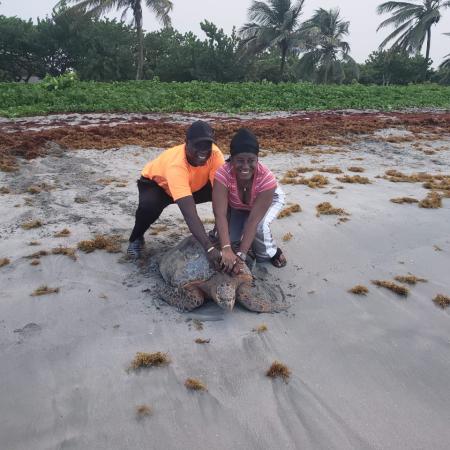
Collaboration between Hotel Workers and the Ranger Team of the Saint Lucia National Trust.
Reported by Augustine Dominique, Conservation Manager
The day began at 6:00 am when I received a call from the Head Ranger of our team at the southern office of the Saint Lucia National Trust that a turtle had made it to the Pointe Sables beach to nest but had become entrapped near the beach overlooking a hotel (Coconut Bay Resort and Spa). It was about to be freed from its entanglement and I was told that this would allow me some time to make the 5–8-minute drive to the area to witness my first turtle sighting since I started the assignment as Project Manager with the southern office of the SLNT. The fact that I was able to witness my first turtle landing on the job symbolizes the importance of collaboration between the community and the SLNT in protecting biodiversity. My wife was more excited than I was to be a part of this adventure, and in 2 minutes we were ready and on our way to Vieux Fort and Pointe Sables Beach, arriving on the beach near the hotel a few minutes later.
There, entangled in some mesh like material near the hotel was a hawksbill turtle. Jeg, SLNT's Head Ranger, was anxious to release the poor creature but had awaited my arrival since I had pleaded with him days earlier to give me a call no matter the hour as I wanted to be present when a turtle was sighted. We made sure to capture the moment on camera while Jeg emphasised the importance and benefits of the developing relationship between our team and the hotel staff. It should be noted that in the past, incidents of poaching of turtles for their meat and eggs which are regarded as local delicacies was a common occurrence. Consequently, the hotel staff and hotel by extension have become key stakeholders in the turtle monitoring programme. This relationship has resulted in a reduction of threats to our marine friends during the time of year when they land on PSEPA’s shores ready to lay their eggs in the act of producing new generations of turtles. The moral of the story was that at a time when the threat of poaching sea turtles was a common practice, a member of the hotel security team had alerted our head ranger of the presence of the trapped turtle on property. This is testament to the relationship that was being developed between the hotel staff and out rangers and speaks volumes regarding the benefits of developing a thorough stakeholder engagement component strategy.

